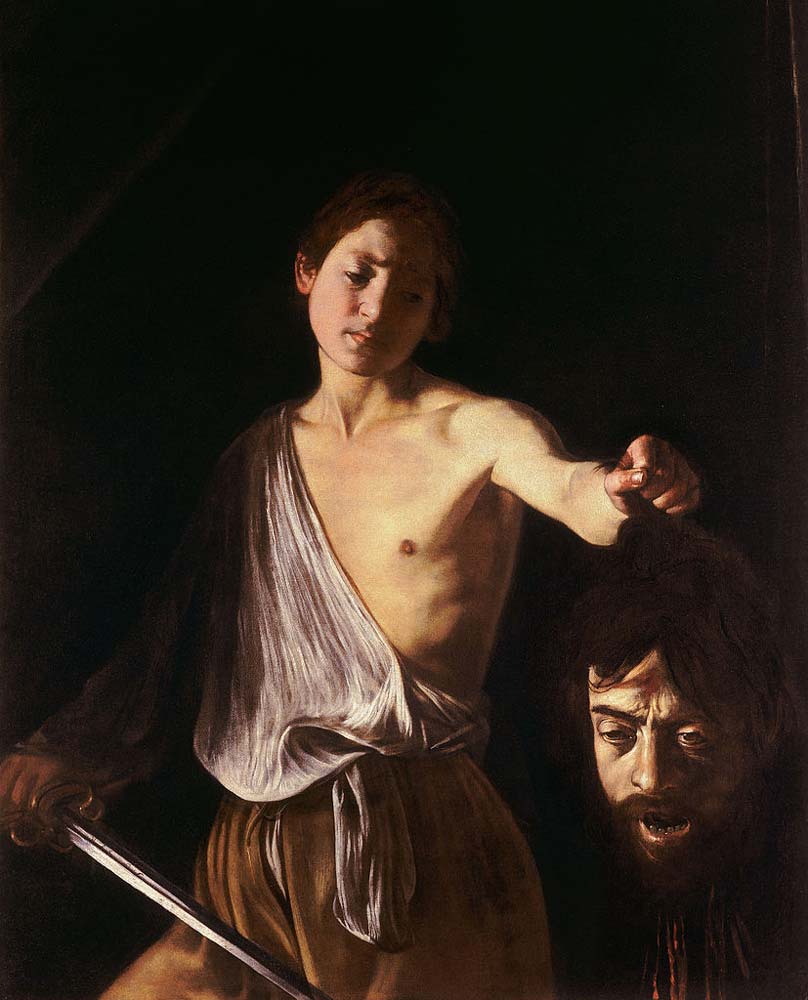| David with the Head of Goliath | |
|---|---|
 |
|
| Artist | Caravaggio |
| Year | c.1610 |
| Medium | Oil on canvas |
| Location | Galleria Borghese, Rome |
| Dimensions | 49 in × 40 in |
| 125 cm × 101 cm | |
| Famous Paintings by Caravaggio | |
| David with the Head of Goliath | |
| Medusa | |
| Bacchus | |
| Conversion of St. Paul | |
| Ecce Homo | |
| Narcissus | |
| Judith Beheading Holofernes | |
| Supper At Emmaus | |
| Sacrifice of Isaac | |
| Complete Works |
A study in the life and tortuous soul of Caravaggio is woven throughout his rendering of David with the Head of Goliath, a painting which has been estimated to have originated in the years between 1605 and 1610.
The Painting
David with the Head of Goliath is, according to art historians, a self-portrait of Caravaggio. Some argue that both figures are representative of Caravaggio, with the young figure of David representing young Caravaggio, and the detached and bloody head of Goliath represents Caravaggio as a man.
The painting shows a young man, David, with his chest partially bared as though his shepherd’s tunic had fallen in disarray in the heat of the conflict. David’s left hand grips the hair from which the decapitated head of Goliath is suspended. Goliath’s mouth is partially open, as though the moment of death was mid-scream. His sightless eyes glare dazedly beneath hooded lids at nothing, as blood drips grotesquely from his detached head.
As David holds the head, he looks at it with a downcast expression that has been the subject of much conjecture. Some believe the look is pensive, compassionate, and filled with remorse. Others see a look of quiet triumph, exemplified by the brightness of his face in contrast with the rest of the painting.
The weapon in David’s hand is not the famous sling of the Biblical story, but Goliath’s own sword which was used by David against him. A close look at the sword shows the following inscription: “H-AS OS” which is believed to be an abbreviation for the Latin phrase “Humilitas occidit superbiam” (humility shall kill pride).
Art Imitates Life
It has been said that all artists portray themselves in their work. As over-generalized as this statement may seem, it does seem applicable to David with the Head of Goliath. The face of Goliath bears a striking resemblance to portraits of Caravaggio as an adult. Some suggest that David is the younger version of Caravaggio, which may bring about the interpretation of the painting as a portrayal of the self-destructive nature that Caravaggio had.
Another theory is that the figure of David is actually that of a young art assistant who lived with Caravaggio, and who may have also been his lover. There is little to substantiate this, other than a single entry written by Caravaggio in which he referred to the young man as the “one who lies with me.”
Regardless of the identities of those portrayed in this intense painting, the emotion with which the painting is charged is still palpable today. The conflict of small vs. massive, the bittersweet victory of winning the fight at the expense of a human life, and the futility of a giant bully against a boy who knows what he must do, is all too evident.
The painting is currently on display at the Galleria Borghese in Rome where it has remained since being sent there by a penitent Caravaggio as a plea to the Pope to remove the price on his head. The Pope did grant his request, but Caravaggio died of a fever before receiving the news.